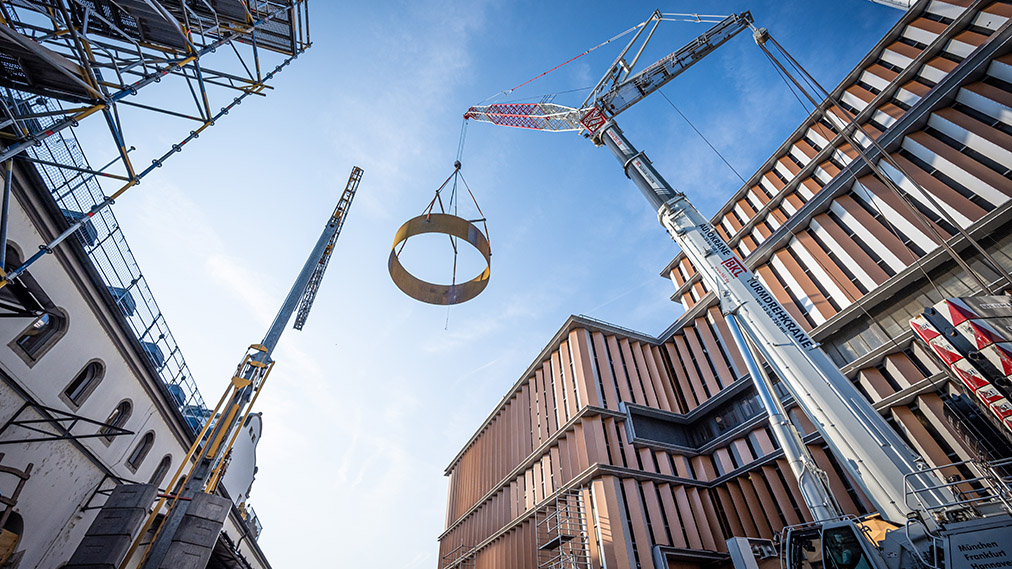Installation of heat storage in Würzburg cogeneration plant
Rethinking energy supply is not only a political and social challenge – it is also an economic one. Regional energy suppliers and municipal utilities in particular have to deal with the question of how they can integrate renewable energies for electricity and heat into their grids at a local level. The existing power plant capacities are often not designed for what the federal and state governments are demanding for the future. Long-term investment in new technologies is currently still too risky, as it is not clear which type of energy generation will prevail in the coming years. However, the accelerated energy transition, rising energy prices and, not least, the Renewable Energy Sources Act (EEG) are increasing the pressure on many suppliers to invest in the expansion and modernization of their power plants now.
Heat storage systems are an efficient way for power plants to use energy more sustainably without having to make costly investments in the planning, construction and operation of completely new or decentralized infrastructures. The example of Würzburger Versorgungs- und Verkehrs-GmbH (WVV), on whose behalf we were commissioned to implement a showcase project for the local strategy towards a “green transition”, demonstrates just how effective a heat storage system can be for the future viability of local energy supplies.

The example of Würzburg: more efficiency in existing buildings
There were originally no plans to expand the combined heat and power plant in inner-city Würzburg to include a heat storage facility. In view of the conurbation, the adjacent architecture of the old town and the climatic and geothermal characteristics of the region, alternatives such as solar thermal energy or combined heat and power plants were initially examined, but the decision was ultimately made in favor of heat storage.
“The time horizon is crucial for us. When we modernize a power plant site, the investment must meet the requirements for efficient supply for the next 15 to 20 years. This requires flexibility in operation. In view of the dynamics of the market, the falling demand for heat and, last but not least, the increasing interest of the population in climate protection, only heat storage actually makes sense in the technological portfolio. Especially as there are no alternatives in an established infrastructure,” says Armin Lewetz, Managing Director of Heizkraftwerk Würzburg GmbH.
Experts at work
Kremsmueller’s special expertise was required precisely because the heat storage tank had to be built as an addition to the existing power station building. To prevent the storage tank from towering disproportionately over the existing building, the foundations were lowered by three meters. The storage tank itself has a diameter of 9.4 meters, a height of 45 meters, weighs 430 tons and buffers a heat quantity of 175,000 kWh. The project will not only change the cityscape, but also the ecological balance of district heating production – 90% of Würzburg’s district heating network is currently supplied by the combined heat and power plant. The expansion will significantly reduce the combined heat and power plant’s CO2 emissions and increase its efficiency by 5%. The storage facility enables district heating to be produced independently of heat demand. Among other things, decoupling also helps to save energy for generating heat. This will make the Würzburg CHP plant much more efficient and economical in future, as it can respond flexibly to the city’s needs.



Solution for the future on site
“With the storage facility, we are relying on a solution that meets the current requirements of the energy industry while remaining sustainable on site – because it can run efficiently independently of energy generation and the expansion strategy of the federal and state governments,” says Lewetz. “The fact that we can rely on Kremsmueller as a partner for the implementation of such a project, a partner who understands the local challenges not only in plant construction but also in the energy industry better than others, is definitely an advantage. Especially for local energy producers who, as an important driving force in the energy transition, can benefit from the implementation expertise in plant and container construction”.
You can find out more about this topic in the specialist area of apparatus engineering and tank construction.

